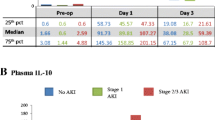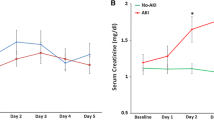Abstract
Purpose
Cardiopulmonary bypass (CPB)-related inflammatory response might be one mechanism by which cardiac surgery associated acute kidney injury (CS-AKI) occurs. Interventions that may attenuate inflammation, including glucocorticoids or phosphodiesterase inhibitors, could therefore have a role in its prevention. We aimed to determine the role of inflammatory mediators in CS-AKI in children and the efficacy of commonly used peri-operative interventions to reduce CS-AKI risk.
Methods
We prospectively studied 109 children undergoing heart surgery. Using regression modeling (adjusting for covariates), we (1) evaluated the association between inflammatory mediators [interleukin (IL)-6, IL-8, C-reactive protein, and tumor necrosis factor-α levels] and CS-AKI, and (2) evaluated risk/prevention factors for CS-AKI including glucocorticoid and milrinone administration. CS-AKI was defined based on pRIFLE methods.
Results
CS-AKI occurred in 68 % of children. No inflammatory mediator measured had an independent association with CS-AKI. Higher pre-operative glomerular filtration rate (GFR), sustained decrease in mean arterial pressure during CPB, post-operative single ventricle physiology, deep hypothermic circulatory arrest, and milrinone use at 24 h post-operatively were significant independent predictors of CS-AKI. Intra-operative steroid administration had no effect on the rate of CS-AKI.
Conclusions
Although inflammatory mediators are up-regulated following CPB, we found no association between levels of inflammatory cytokines and CS-AKI. CS-AKI has complex pathophysiology and the observation that milrinone was associated with increased AKI risk (and that higher GFR predicts more injury) suggests that mechanisms beyond inflammation play a significant role. Intra-operative administration of glucocorticoid does not appear to be an effective intervention for reducing the risk of CS-AKI.

Similar content being viewed by others
Abbreviations
- AKI:
-
Acute kidney injury
- CPB:
-
Cardiopulmonary bypass
- CRP:
-
C-reactive protein
- CRRT:
-
Continuous renal replacement therapy
- CS-AKI:
-
Cardiac surgery associated AKI
- DHCA:
-
Deep hypothermic circulatory arrest
- eCCl:
-
Estimated creatinine clearance
- ECMO:
-
Extracorporeal membrane oxygenation
- eGFR:
-
Estimated glomerular filtration rate
- GFR:
-
Glomerular filtration rate
- IL-6:
-
Interleukin 6
- IL-8:
-
Interleukin 8
- IQR:
-
Interquartile range
- MAP:
-
Mean arterial pressure
- PD:
-
Peritoneal dialysis
- POD:
-
Post-operative day
- RACHS-1:
-
Risk Adjustment for Congenital Heart Surgery 1
- SCr:
-
Serum creatinine
- SD:
-
Standard deviation
- sTNFR:
-
Soluble tumor necrosis factor receptor
- SV:
-
Single ventricle
References
Akcan-Arikan A, Zappitelli M, Loftis LL, Washburn KK, Jefferson LS, Goldstein SL (2007) Modified RIFLE criteria in critically ill children with acute kidney injury. Kidney Int 71:1028–1035. doi:10.1038/sj.ki.5002231
Zappitelli M, Moffett BS, Hyder A, Goldstein SL (2011) Acute kidney injury in non-critically ill children treated with aminoglycoside antibiotics in a tertiary healthcare centre: a retrospective cohort study. Nephrol Dial Transpl 26:144–150. doi:10.1093/ndt/gfq375
Plotz FB, Hulst HE, Twisk JW, Bokenkamp A, Markhorst DG, van Wijk JA (2005) Effect of acute renal failure on outcome in children with severe septic shock. Pediatr Nephrol 20:1177–1181. doi:10.1007/s00467-005-1946-1
Schneider J, Khemani R, Grushkin C, Bart R (2010) Serum creatinine as stratified in the RIFLE score for acute kidney injury is associated with mortality and length of stay for children in the pediatric intensive care unit. Crit Care Med 38:933–939. doi:10.1097/CCM.0b013e3181cd12e1
Coca SG, Yusuf B, Shlipak MG, Garg AX, Parikh CR (2009) Long-term risk of mortality and other adverse outcomes after acute kidney injury: a systematic review and meta-analysis. Am J Kidney Dis 53:961–973. doi:10.1053/j.ajkd.2008.11.034
Schmitt R, Coca S, Kanbay M, Tinetti ME, Cantley LG, Parikh CR (2008) Recovery of kidney function after acute kidney injury in the elderly: a systematic review and meta-analysis. Am J Kidney Dis 52:262–271. doi:10.1053/j.ajkd.2008.03.005
Casey LC (1993) Role of cytokines in the pathogenesis of cardiopulmonary-induced multisystem organ failure. Ann Thorac Surg 56:S92–S96. doi:10.1016/0003-4975(93)91143-B
Kalfin RE, Engelman RM, Rousou JA, Flack JE 3rd, Deaton DW, Kreutzer DL, Das DK (1993) Induction of interleukin-8 expression during cardiopulmonary bypass. Circulation 88:II401–II406
Finn A, Naik S, Klein N, Levinsky RJ, Strobel S, Elliott M (1993) Interleukin-8 release and neutrophil degranulation after pediatric cardiopulmonary bypass. J Thorac Cardiovasc Surg 105:234–241
Asimakopoulos G (2001) Systemic inflammation and cardiac surgery: an update. Perfusion 16:353–360. doi:10.1177/026765910101600505
Nishiki T, Kitada H, Okabe Y, Miura Y, Kurihara K, Kawanami S, Tanaka M (2011) Effect of milrinone on ischemia-reperfusion injury in the rat kidney. Transpl Proc 43:1489–1494. doi:10.1016/j.transproceed.2011.03.009
Lanfear DE, Hasan R, Gupta RC et al (2009) Short term effects of milrinone on biomarkers of necrosis, apoptosis, and inflammation in patients with severe heart failure. J Transl Med 7:67. doi:10.1186/1479-5876-7-67
Jenkins KJ, Gauvreau K, Newburger JW, Spray TL, Moller JH, Iezzoni LI (2002) Consensus-based method for risk adjustment for surgery for congenital heart disease. J Thorac Cardiovasc Surg 123:110–118. doi:10.1067/mtc.2002.119064
Wernovsky G, Wypij D, Jonas RA et al (1995) Postoperative course and hemodynamic profile after the arterial switch operation in neonates and infants. A comparison of low-flow cardiopulmonary bypass and circulatory arrest. Circulation 92:2226–2235. doi:10.1161/01.CIR.92.8.2226
Aronen M, Leijala M, Meri S (1990) Value of C-reactive protein in reflecting the magnitude of complement activation in children undergoing open heart surgery. Intensive Care Med 16:128–132. doi:10.1007/BF02575308
Butler J, Parker D, Pillai R, Westaby S, Shale DJ, Rocker GM (1993) Effect of cardiopulmonary bypass on systemic release of neutrophil elastase and tumor necrosis factor. J Thorac Cardiovasc Surg 105:25–30
Chew MS, Brandslund I, Brix-Christensen V et al (2001) Tissue injury and the inflammatory response to pediatric cardiac surgery with cardiopulmonary bypass: a descriptive study. Anesthesiology 94:745–753
el-Barbary M, Khabar KS (2002) Soluble tumor necrosis factor receptor p55 predicts cytokinemia and systemic inflammatory response after cardiopulmonary bypass. Crit Care Med 30:1712–1716
Hirai S, Sueda T, Orihashi K, Watari M, Okada K (2001) Kinetics of pro-inflammatory cytokines release in cardiac surgery with cardiopulmonary bypass. Jpn J Thorac Cardiovasc Surg 49:216–219. doi:10.1007/BF02913518
Gormley SM, McBride WT, Armstrong MA et al (2000) Plasma and urinary cytokine homeostasis and renal dysfunction during cardiac surgery. Anesthesiology 93:1210–1216. doi:10.1097/00000542-200011000-00013
Stenvinkel P, Ketteler M, Johnson RJ et al (2005) IL-10, IL-6, and TNF-alpha: central factors in the altered cytokine network of uremia—the good, the bad, and the ugly. Kidney Int 67:1216–1233. doi:10.1111/j.1523-1755.2005.00200.x
Diez-Ruiz A, Tilz GP, Zangerle R, Baier-Bitterlich G, Wachter H, Fuchs D (1995) Soluble receptors for tumour necrosis factor in clinical laboratory diagnosis. Eur J Haematol 54:1–8. doi:10.1111/j.1600-0609.1995.tb01618.x
Schwartz GJ, Munoz A, Schneider MF, Mak RH, Kaskel F, Warady BA, Furth SL (2009) New equations to estimate GFR in children with CKD. J Am Soc Nephrol 20:629–637. doi:10.1681/ASN.2008030287
Alkandari O, Eddington KA, Hyder A et al (2011) Acute kidney injury is an independent risk factor for pediatric intensive care unit mortality, longer length of stay and prolonged mechanical ventilation in critically ill children: a two-center retrospective cohort study. Crit Care 15:R146. doi:10.1186/cc10269
Mickey RM, Greenland S (1989) The impact of confounder selection criteria on effect estimation. Am J Epidemiol 129:125–137
Bursac Z, Gauss CH, Williams DK, Hosmer DW (2008) Purposeful selection of variables in logistic regression. Source Code Biol Med 3:17. doi:10.1186/1751-0473-3-17
Li S, Krawczeski CD, Zappitelli M et al (2011) Incidence, risk factors, and outcomes of acute kidney injury after pediatric cardiac surgery: a prospective multicenter study. Crit Care Med 39:1493–1499. doi:10.1097/CCM.0b013e31821201d3
Zabrocki LA, Brogan TV, Statler KD, Poss WB, Rollins MD, Bratton SL (2011) Extracorporeal membrane oxygenation for pediatric respiratory failure: survival and predictors of mortality. Crit Care Med 39:364–370. doi:10.1097/CCM.0b013e3181fb7b35
Skippen PW, Krahn GE (2005) Acute renal failure in children undergoing cardiopulmonary bypass. Crit Care Resusc 7:286–291
Liu KD, Altmann C, Smits G, Krawczeski CD, Edelstein CL, Devarajan P, Faubel S (2009) Serum interleukin-6 and interleukin-8 are early biomarkers of acute kidney injury and predict prolonged mechanical ventilation in children undergoing cardiac surgery: a case-control study. Crit Care 13:R104. doi:10.1186/cc7940
Morgan CJ, Zappitelli M, Robertson CM, et al. (2012) Risk factors for and outcomes of acute kidney injury in neonates undergoing complex cardiac surgery. J Pediatr. doi:10.1016/j.jpeds.2012.06.054 (Epub ahead of print)
Ho J, Lucy M, Krokhin O et al (2009) Mass spectrometry-based proteomic analysis of urine in acute kidney injury following cardiopulmonary bypass: a nested case-control study. Am J Kidney Dis 53:584–595. doi:10.1053/j.ajkd.2008.10.037
Dennen P, Altmann C, Kaufman J et al (2010) Urine interleukin-6 is an early biomarker of acute kidney injury in children undergoing cardiac surgery. Crit Care 14:R181. doi:10.1186/cc9289
Chiravuri SD, Riegger LQ, Christensen R, Butler RR, Malviya S, Tait AR, Voepel-Lewis T (2011) Factors associated with acute kidney injury or failure in children undergoing cardiopulmonary bypass: a case-controlled study. Paediatr Anaesth 21:880–886. doi:10.1111/j.1460-9592.2011.03532.x
Ricci Z, Picca S, Guzzo I, Ronco C (2011) Kidney diseases beyond nephrology: intensive care. Nephrol Dial Transpl 26:448–454. doi:10.1093/ndt/gfq800
Zappitelli M, Krawczeski CD, Devarajan P et al (2011) Early postoperative serum cystatin C predicts severe acute kidney injury following pediatric cardiac surgery. Kidney Int 80:655–662. doi:10.1038/ki.2011.123
Burlet A, Drukker A, Guignard JP (1999) Renal function in cyanotic congenital heart disease. Nephron 81:296–300. doi:10.1159/000045296
Ali ZA, Callaghan CJ, Lim E et al (2007) Remote ischemic preconditioning reduces myocardial and renal injury after elective abdominal aortic aneurysm repair: a randomized controlled trial. Circulation 116:I98–I105. doi:10.1161/circulationaha.106.679167
Park KM, Chen A, Bonventre JV (2001) Prevention of kidney ischemia/reperfusion-induced functional injury and JNK, p38, and MAPK kinase activation by remote ischemic pretreatment. J Biol Chem 276:11870–11876. doi:10.1074/jbc.M007518200
Buchhorn R, Hammersen A, Bartmus D, Bursch J (2001) The pathogenesis of heart failure in infants with congenital heart disease. Cardiol Young 11:498–504. doi:10.1017/S1047951101000725
Redfors B, Sward K, Sellgren J, Ricksten SE (2009) Effects of mannitol alone and mannitol plus furosemide on renal oxygen consumption, blood flow and glomerular filtration after cardiac surgery. Intensive Care Med 35:115–122. doi:10.1007/s00134-008-1206-5
Antonelli M, Azoulay E, Bonten M et al (2010) Year in review in Intensive Care Medicine 2009: I. Pneumonia and infections, sepsis, outcome, acute renal failure and acid base, nutrition and glycaemic control. Intensive Care Med 36:196–209. doi:10.1007/s00134-009-1742-7
Acknowledgments
Financial support was provided by the Stollery Children’s Hospital Foundation. P. G. was supported by the Rhodes Trust, Alberta Innovates–Health Solutions and Canadian Institute of Health Research.
Conflicts of interest
The authors declare that they have no competing interests.
Author information
Authors and Affiliations
Corresponding author
Rights and permissions
About this article
Cite this article
Morgan, C.J., Gill, P.J., Lam, S. et al. Peri-operative interventions, but not inflammatory mediators, increase risk of acute kidney injury after cardiac surgery: a prospective cohort study. Intensive Care Med 39, 934–941 (2013). https://doi.org/10.1007/s00134-013-2849-4
Received:
Accepted:
Published:
Issue Date:
DOI: https://doi.org/10.1007/s00134-013-2849-4




